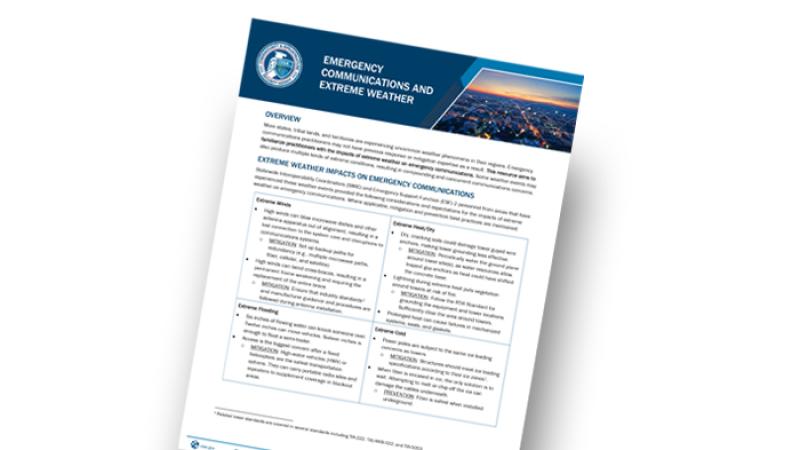Archived Content
In an effort to keep CISA.gov current, the archive contains outdated information that may not reflect current policy or programs.
Extreme Weather
Overview
Over the last 50 years, much of the U.S. has seen increases in prolonged periods of excessively high temperatures and an associated expansion of drought. This contributes to larger wildfires burning more acreage per incident, heavier downpours leading to torrential flooding, more intense winter weather events, stronger tropical storms, and a persistent increase in sea level rise across all coasts as baseline temperatures continue to rise.
These shifts from severe weather to more damaging events nation-wide has led to impacts across all 16 critical infrastructure sectors and a growing need to improve resiliency. Extreme weather events have become far more disruptive and destructive than ever recorded and are projected to steadily worsen.
CISA’s Role
It is CISA’s mission to ensure critical infrastructure is protected against extreme weather threats and events. Infrastructure built in the 1900s to early 2000s using climate data from the mid-1900s lacks the ability to withstand the changes occurring in both intensity and frequency of extreme weather events and could experience excessive damage or destruction.
CISA analyzes extreme weather and its impacts to critical infrastructure. We discuss potential increases in weather damages with infrastructure owners and operators, conduct exercises centered around damages from major weather events with stakeholders, and develop resiliency focus documents to outline practical guidelines and strategies for implementation.
CISA analyzes and shares current data trends and findings through:
- Open-Source weekly summaries on national-international climate studies, recent weather impacts, new research opportunities, and products focused on extreme weather.
- Presentations about national, regional, state, or infrastructure-related climate impacts and the cascading effects to physical infrastructure, site operations, and community resilience.
- Impact analyses of National Critical Functions.
- CISA and the Homeland Security Operational Analysis Center (HSOAC) developed a risk management framework to assess the risk of extreme weather to higher vulnerability NCFs.
- Regional Resiliency Assessment Program (RRAP) reports addressing the impacts of extreme weather events to a sector or region for cascading impacts.
- There are several ongoing and planned RRAPs with climate impact-related aspects, such as drought, sea level rise, and harmful algal blooms affecting water supply.
- Factsheet to address extreme weather impacts to telecommunications.
CISA, through the Analytic Exchange Program (AEP), produced a website to further engagement with critical infrastructure owners and operators as well as communities across the nation by providing amplifying information on each of the eight worsening weather hazards, methods of identifying site-specific extreme weather forecasts, and federally backed climate resiliency options for consideration with associated funding opportunities from both government and private sector entities.
- This website hosts numerous studies, factsheets, and resources from interagency partners and the scientific community, furthering CISA’s commitment to a whole-of-government approach to resiliency planning and coordination of mitigation efforts.
https://experience.arcgis.com/experience/a1ec0d1276064ae387c863f2a14b11e1/
Severe Weather vs. Extreme Weather
Severe weather is considered to be an intense variation of a regionally common weather event, such as a heavy rainfall event or damaging winds. Extreme weather identifies the trend of more severe weather events both in frequency and intensity, such as torrential rain (excessive rain periods where over one month of rain can fall during a single storm) or record-breaking peak gusts with widespread wind damage.
Extreme weather is the most intense climate element observed during a given period, typically longer lasting or more damaging than the historical ‘worst case’ events. Infrastructure is built to climatological norms for the 20-40 years prior to development, accounting for typical severe weather events experienced regionally but not planning for withstanding extreme weather events. As extreme weather events become more common, critical infrastructure sites will need to revisit building codes, material limitations, and regional damages during past severe events to address areas at greatest immediate risk.
Extreme Weather Threats
Extreme weather threats are occurrences of unusually severe weather that can cause devastating impacts on communities, infrastructure, agricultural, and natural ecosystems.
Prolonged Drought
Droughts have become more frequent, longer, and more severe, causing billions of dollars in damages in the U.S. Droughts can impact critical infrastructure sectors such as transportation, energy and water that millions of Americans depend upon.
Extreme Heat
The ten warmest years in the 143-year record have all occurred since 2010, with the last nine years (2014–2022) ranking as the nine warmest years on record. Heat events can damage transportation, lead to power outages, and threaten public health.
Wildfires
Over the past 40 years, the average number of acres of forested land consumed by wildfire each year in the United States has increased by 1,000%. Wildfires can disrupt transportation, communications, power and gas services, and water supply.
Extreme Cold
Over the past 40 years, major extreme cold events have caused disasters totaling over $120 billion dollars. Damages from these events were caused by icing, freezing rain, heavy snow, ice storms, freezing spray/fog, and lake effect.
Sea Level Rise
Of the 25 most densely populated and rapidly growing U.S. counties, 23 are along a coast facing exposed infrastructure networks, saltwater contamination, immobilization of transportation, grid failures, and prolonged disruption.
Torrential Flooding
Over the past 20 years the US has reported 4x the amount of billion-dollar flood disasters compared to 1980-2000. Large floods can damage assets in nearly all critical infrastructure sectors and can be life threatening.
Tropical Cyclones
Climate amplified tropical cyclones have caused over $1,333 billion in damages since 1980. Winds, hail, and rising waters in a storm path can span numerous states and cause severe damage to critical infrastructure systems.
Severe Storms
Since 1980, severe storms have caused over $383 billion in total damages. As developments in hazardous areas continue and atmospheric instability increases, critical infrastructure sites will see increased damage.
CISA in Action
Discover how CISA is working to protect our national critical infrastructure from extreme weather and climate-related events.
In the Eye of the storm

Emergency Communications and Extreme Weather Factsheet
Weather Happens – CISA Helps Keep Critical Infrastructure Prepared
Extreme Weather Resources and Publications
View All Extreme Weather ResourcesDrought and Extreme Heat Impacts to Data Centers in Northern California

Infrastructure Resilience Planning Framework (IRPF)
Drought Guide
CISA Resilient Power Best Practices for Critical Facilities and Sites
2023 Chemical Security Summit Presentations
Partnerships
CISA partners with other agencies and groups with weather-related expertise and knowledge to further advance our mission to protect critical infrastructure systems.
NOAA’s National Center for Environmental Information (NCEI)
NCEI provides recurring reports covering national weather events, global climate extremes, drought updates, wildfire statistics, snow and ice coverage, tornado trends, and more.
National Climate Assessment
The Fifth National Climate Assessment is the US Government’s preeminent report on extreme weather impacts, risks, and responses.
Federal Emergency Management Agency (FEMA)
FEMA works with state, local, tribal and territorial governments to build and deliver resources and capabilities that ensure the nation can withstand climate hazards of today and those we anticipate for tomorrow.
Climate Mapping for Resilience and Adaptation
Discover climate-related hazards through this portal.
NOAA's Climate.gov
NOAA’s Climate.gov provides timely and authoritative scientific data and information about climate science, adaptation, and mitigation.
Additional Federal Resources
The EPA’s Climate indicators provide evidence of extreme weather and their impacts on people and the environment.
The USDA's Climate Hub features events, resources and tools to address challenges and responses to the nation's agriculture due to extreme weather.
DOT's Climate and Sustainability demonstrates how the DOT is committed to using all of its authorities to substantially reduce greenhouse gas emissions and transportation-related pollution and build a more resilient and sustainable transportation systems to benefit communities.
DOD's Tackling Extreme Weather shows how the DOD is elevating this as a national security priority, integrating climate considerations into policies, strategies and partner engagements.
The Environment and Natural Resources Division (ENRD) is responsible for bringing cases against those who violate the nation’s environmental laws as well as defending the federal government in litigation arising under a broad range of environmental statutes.
Learn more about how the GSA is developing robust and resilient capacity to manage extreme weather risks and secure federal real property and supply chain investments.
The DOI's Tackling Extreme Weather prioritizes action for a more equitable and sustainable future.
At the DOS's The Climate Crisis: Working Together for Future Generations, learn more about how the United States is doing its part to build a net zero-emission, resilient future that creates good jobs and ensures a healthy, livable planet for generations to come.
Contact Us
To request a service or ask a question about Extreme Weather, please send an email to Extreme.Weather@CISA.DHS.GOV.




